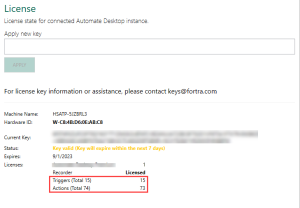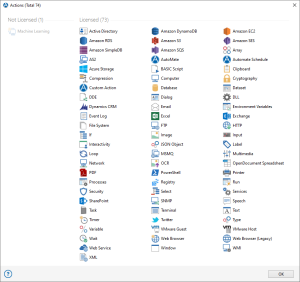Licensing & Maintenance
Overview
Automate Desktop is designed to offer specific software editions and feature
sets to enable scalability for small businesses to large enterprises.
The available licensing models allows you to start small and upscale your
platform requirements to support business growth as necessary, all without
any down-time periods or difficult changes. Automate Desktop editions offer an
extremely cost effective means of automating a single desktop or multiple
machines.
You can acquire a basic, stand-alone license primarily designed for
individual desktop automation or one that allows remote deployment and
execution of tasks and processes. In addition, the newly developed feature-based
licensing model enables you to acquire actions and triggers individually.
All purchased editions and feature sets are tied to a single license key.
Adding new features or upgrading to a new edition is as simple as entering
a new license key. See License for additional
details.
For the latest information on Automate Desktop features, see https://www.fortra.com/product-lines/automate.
The fastest and least painful solution to reduce software costs
is to eliminate unnecessary, under-utilized or unused features. Automate Desktop
supports feature-based licensing, which benefits those that require
use of only specific actions or triggers by allowing such items to
be licensed separately. This type of licensing can reduce initial
purchasing expenses and provide monetary savings for a company. As
the company grows, additional actions and/or triggers can be licensed
to fit increased development and operations. Adding new capabilities
only requires a new license key to turn on new actions or triggers,
once they are purchased.
The Task Administrator's
License page provides information
about currently licensed and unlicensed actions and triggers (shown
below). They indicate the total number of actions or triggers available
for purchase and ones that are already purchased, included in the
current license, and active for use.
Viewing licensed vs. unlicensed actions
To view a full list of individually licensed vs. unlicensed actions on the License screen,
select Actions. This opens a dialog separating currently unlicensed and
licensed actions (shown below).
Each action is listed by their respective icon, however,
the unlicensed actions will be dimmed. To view more details about
a specific action, hover the mouse pointer over it.
Viewing licensed vs. unlicensed triggers
To view a full list of individually licensed vs. unlicensed triggers on the License screen,
select Triggers.
This opens a dialog separating currently unlicensed and licensed
triggers (shown below).
Each trigger is listed by their respective icon, however,
the unlicensed triggers will be dimmed. To view more details about
a specific trigger, hover your mouse pointer over it.
Trial license
You can request a trial
license to evaluate a fully
functional copy of Automate Desktop before making a purchase. A trial
license is a free, non-commercial, short-term license designed to
enable usage and examination of the software to determine whether
it is a good fit for you and your organization's needs. The
trial period
begins upon initial software installation and lasts for a period of
30 days.
Permanent license
Unlike a trial license, a permanent license is a standard paid license
acquired upon purchase of Automate Desktop. Once obtained, the permanent license replaces
the trial license and is used for software validation for
the duration of the term. If multiple licenses are purchased,
each one will appear in the License
page of Task Administrator.
License validation is a procedure that reduces piracy by verifying
the software license is valid and used in accordance with the
End User License Agreement (EULA). It also ensures the software
is not being used on any device other than the one for which it was
purchased.
When Automate Desktop
starts,
it reads the available license key along with the local computer's
hardware ID to determine its validity. The hardware ID is a short
character string that represents the computer's hard
disk ID, Ethernet MAC address and other unique hardware elements.
It is tied directly with the license key entered and used to identify
the hardware platform on which Automate Desktop is installed. You can also
generate a hardware ID on computers where you intend to install Automate Desktop by using the Hardware ID Provider application.
A change to the network interface
(physical, virtual, or wireless) may generate a hardware ID mismatch
error, and in turn require a new license key. For more details about obtaining a new license, see Requesting a New
Permanent License Key.
Automate Desktop also
keeps track of the license expiration date. If a license is
about to reach the end of its term, Automate Desktop alerts the user ahead
of time by way of a warning. This warning appears each time the Automate Desktop
service starts until the end of the term.
Product maintenance is a contractual
agreement ensuring that the user will receive access to all major and minor
updates in addition to unlimited technical support during the duration of an active maintenance term.
A maintenance entitlement is required for all licensed Automate products
and will be included with the original license purchase. For subscription licenses, maintenance benefits are included in the annual subscription cost. Maintenance and subscriptions are renewable at the conclusion of the contract term.
Maintenance or subscription expiry will restrict access to new product versions, technical support, and licensing support. To retain full functionality and support benefits, it is important to renew maintenance at the end of each term.
 Feature-based
licensing
Feature-based
licensing
 Trial
vs. permanent license
Trial
vs. permanent license
 License
validation
License
validation
 Product
maintenance
Product
maintenance


